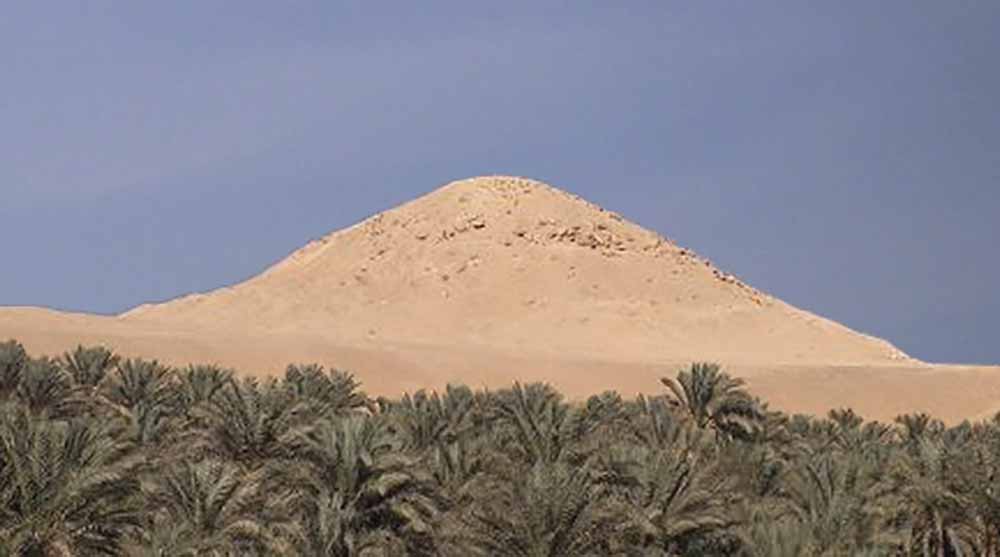

Original name: The pyramid of Isesi is beautiful
Original height: 52.5 m / 175 ft
Base length: 78.5 m / 262 ft
Angle of inclination: 53° 7' 48"
Date of construction: 6th dynasty
The Pyramid of Djedkare Isesi (in ancient Egyptian Nefer-Djed-ka-re is a late 25th to mid 24th century BC pyramid complex built for the Fifth Dynasty pharaoh Djedkare Isesi. The pyramid is referred to as Haram el-Shawaf manning 'The Sentinel Pyramid') by locals. It was the first pyramid to be built in South Saqqara.
Djedkare Isesi's monument complex encompasses: a main pyramid; a mortuary temple situated on the east face of the main pyramid; a valley temple buried under modern Saqqara; a causeway that has been only partially dug out; and a cult pyramid. The main pyramid had a six-stepped core built from roughly cut limestone bound together by clay mortar which was then encased in fine white Tura limestone reaching a peak height of 52.5 m (172 ft; 100.2 cu).
The casing has been plundered, and the top three steps of the core have been lost, leaving the pyramid a paltry 24 m (79 ft; 46 cu) tall. The basic dimensions of Djedkare's pyramid were adopted by succeeding kings in their own funerary monuments. Inside Djedkare Isesi's pyramid substructure, remains of the burial have been found alongside the mummy remains of Djedkare Isesi himself. The mummy and linen wrapping have undergone Carbon-14 dating which have given a common range of 2886Đ2507 BC. The substructure has otherwise been badly damaged by stone thieves quarrying the Tura limestone casing.
Adjoining the pyramid's east face is the mortuary temple. Flanking the entrance hall to the temple are two large pylon structures. West of the south pylon, a large building with multiple long narrow rooms was discovered. The outline of the building has been preserved by foundational blocks, but its structure is otherwise poorly preserved, and its floor has been lost, possibly to stone thieves. The building has no contemporaries at other Old Kingdom pyramid complexes, and no companion on the north side. Its function is unknown. The mortuary temple was mostly destroyed during the Second Intermediate Period, and used as a burial site in the Eighteenth Dynasty. At the south-east corner of the pyramid, a small cult pyramid is found in an enclosure. It has a T-shaped substructure.
At the north-east corner of the pyramid complex's enclosure wall, a satellite pyramid complex belonging to Queen Setibhor was built. The sub-complex is the largest one built for a queen during the Old Kingdom. It has its own enclosure wall, a mortuary temple and offering hall, storage rooms, antichambre carree of unparalleled size, a small cult pyramid, and otherwise incorporates features that were previously reserved exclusively for the complexes of the king.
The last kings of the Fifth Dynasty moved their funerary building activities from Abusir back to Saqqara. Djedkare Isesi built his pyramid 6 km (3.7 mi) from the Abusir necropolis at a site in South Saqqara. It was the first pyramid to be built in that area. He also abandoned the tradition of building sun temples, indicating a shift in the religious significance from the cult of Ra to the cult of Osiris.
The pyramid was briefly visited by John Shae Perring, and soon after that by Karl Richard Lepsius. The substructure of the pyramid was first explored in 1880 by Gaston Maspero. In the mid-1940s, Alexander Varille and Abdel Salam Hussein attempted the first comprehensive examination of the pyramid, but their work was interrupted and their findings lost. They did discover the skeletal remains of Djedkare Isesi in the pyramid. Ahmed Fakhry's attempt at a comprehensive examination in the 1950s was equally unsuccessful. Relief fragments that Fakhry had discovered were later published by Muhammud Mursi. The area around the causeway and mortuary temple was excavated by Mahmud Abdel Razek.
Architectural plans of the pyramid complex were first published by Vito Maragioglio and Celeste Rinaldi between 1962 and 1977. These have been determined by Mohamed Megahed, Peter Janosi and Hana Vymazalova to be inconsistent and inaccurate. Since 2010, Megahed has been the director in charge of the pyramids of Djedkare Isesi and Setibhor.
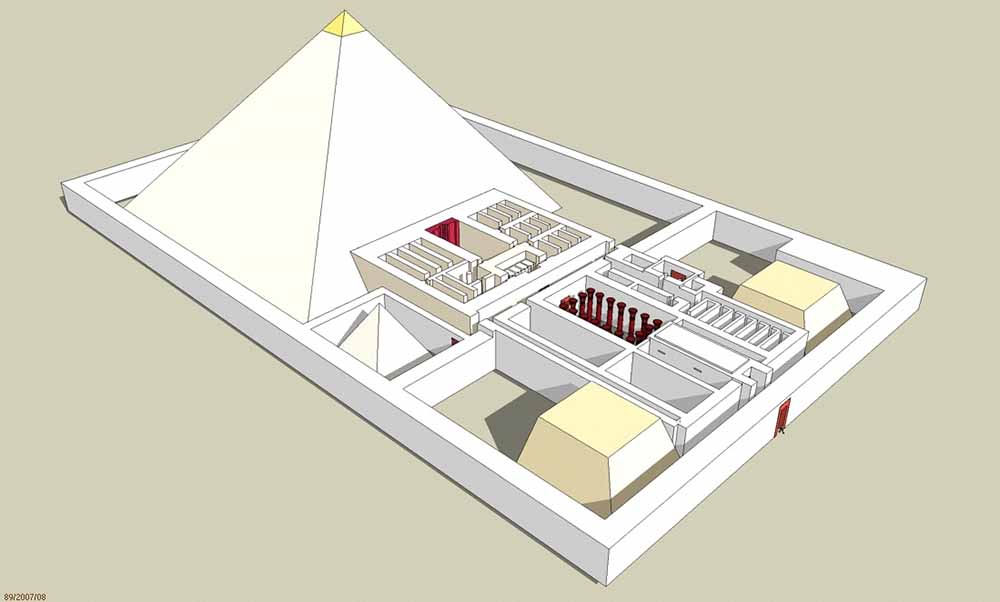
Old Kingdom mortuary complexes consisted of five essential components: (
1) a valley temple;
2) a causeway;
3) a pyramid, or mortuary, temple;
4) a cult, or satellite, pyramid;
5) the main pyramid. Djedkare's monument has all of these elements. The main pyramid constructed from six steps of limestone blocks. A valley temple, buried under the modern houses of Saqqara. A causeway, that has not yet been excavated. A mortuary temple on the east side of the pyramid, and a cult pyramid at the south-east corner of the main pyramid, with a standard T-shaped substructure. Additionally, there is an associated pyramid situated on the north-east corner of Djedkare's pyramid complex, belonging to Setibhor, previously known as the "pyramid of the unknown queen".
The core of the pyramid was constructed in six steps composed of small irregular pieces of limestone blocks bound together using clay mortar. The length of the base step of the pyramid was 78.75 m (258 ft; 150 cu), with each step built around 7 metres (23 ft; 13 cu) high, converging to the peak at a slope of 52° giving the pyramid an original peak height of 52.5 m (172 ft; 100 cu). These proportions were used by the rulers Teti, Pepi I, Merenre I,[b] and Pepi II for their pyramid complexes. The top three steps of the pyramid no longer exist, and ruined pyramid now reaches a height of about 24 metres (79 ft; 46 cu). The pyramid was originally encased with fine white Tura limestone. Most of the casing has since been plundered, though some of it has remained intact and has been well preserved.
Entry into the substructure was gained from the north side of the pyramid; unusually, however, the entrance is under the pavement of the courtyard, instead of in the north face. There was originally a north chapel here; only traces of it now remain. The entry leads into a granite lined downward sloping access corridor.
The corridor has a slight angle toward the east, and is the last built to do so. The corridor ends at a vestibule, through which a second corridor lined with limestone, the horizontal passage, is accessed. Remnants of broken vessels were discovered in the vestibule, suggesting that certain burial rituals had been performed there.
The horizontal passage was guarded by three granite portcullises near the beginning of the corridor, and a fourth granite portcullis near its end. The exit of the horizontal passage leads into the antechamber, a room measuring 4.02 m (13.2 ft) by 3.1 m (10 ft). To east was a room, the serdab, containing three niches for storage, a developing feature of pyramids of the era. To the west lay the burial chamber, measuring 7.84 m (25.7 ft) by 3.1 m (10 ft), which once contained the basalt sarcophagus of the ruler. Fragments of the sarcophagus were found in a 13 cm (5 in) depression in the floor. The roof of both the antechamber and burial chamber were constructed from two, or perhaps three, layers of gabled limestone blocks, in the same fashion as the pyramids in Abusir. These blocks were 5.25 m (17.2 ft; 10.02 cu) in length.
The rooms of the substructure have been badly damaged by stone thieves, who quarried the Tura limestone walls of the chambers,which has made reconstruction of the planned layout difficult. The serdab was left alone, preserving its structure and flat roof. The masonry core has been exposed in the other chambers, and consists of crudely cut blocks and small limestone chips that were piled up to form the substructure of the pyramid. The wall separating the antechamber and burial chamber has been total demolished. The substructure has been subject to significant on-going restoration work, particularly the consolidation of the pyramid's core and the walls of the antechamber and serdab.
Djedkare's sarcophagus originally sat near the west wall of the burial chamber. At the south-east foot of the sarcophagus, alabaster canopic jars had once buried in a small hole in the ground. Underneath the rubble, only fragments of the sarcophagus and alabaster jars have been found, along with a mummified body of a man in his fifties that is presumed to be the remains of Djedkare Isesi. The mummy has been subjected to Carbon-14 dating, as have scraps of linen wrapping and charcoal taken from the tomb. These samples have provided a range of dates spanning 3340Đ2460 BC, and a common range of 2886-2507 BC. Miroslav Verner remarks that these results accord better with earlier proposed regnal dates than later ones, but contradicts previous astronomically derived dates which favour later proposed regnal dates than earlier ones.
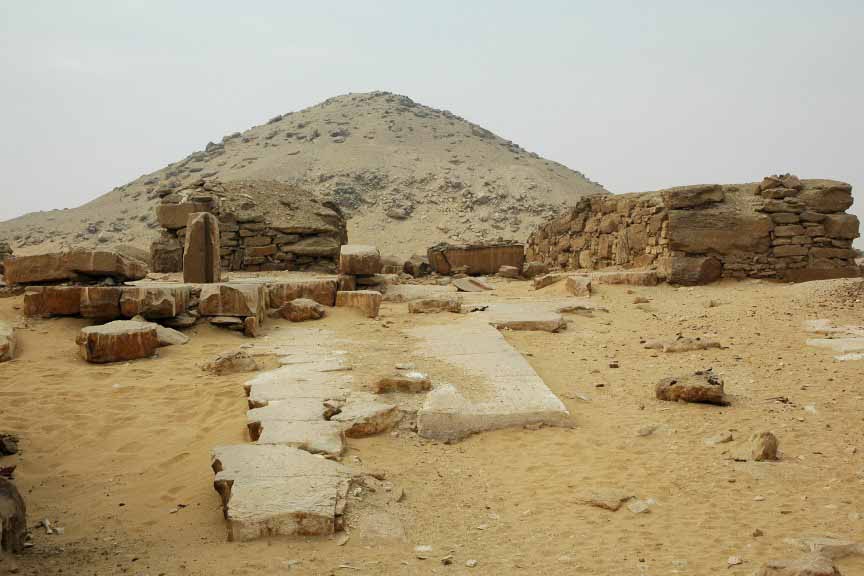
The valley temple to Djedkare's complex has not been excavated, it is lost buried under the modern houses of Saqqara.
The causeway that leads up to the mortuary temple has not been excavated, though it is known to have a straight sloped path, running slightly southwards, and a length of 220 m (722 ft; 420 cu). The ground where the mortuary temple was to be constructed had a sharp downward slope towards the desert, and needed extensive preparation before the laying of the foundation.
Dimensions for the causeway are speculative, based only on the trace remains of existing foundations. The causeway had walls approximately 2.4 m (7.9 ft) thick, with a path between them no more than 2.6 m (8.5 ft) wide.
The height of the structure remains unknown, though it is clear that it had a ceiling and was covered based on blocks found painted with stars, a typical motif for the ceiling. It appears to have been made entirely of white limestone, the same material that makes up the causeway to Sahure's pyramid. The walls were clearly decorated with raised relief.
The causeway connects to the temple entrance hall between two large pylon structures, an innovation from Nyuserre's pyramid, which were square with slightly inclined walls. The pylons were once 6 m (20 ft; 11 cu) tall, but have since been reduced to 4.5 m (15 ft). There may have been stairs leading up to the terrace, but likely had no rooms inside. Their function remains a mystery.
Alongside the causeway, leading towards the courtyard of the temple, a water drain was discovered. The drain was made of crudely cut blocks of quartzite that had been carelessly set. No traces of the drain have been found in the entrance hall or courtyard.
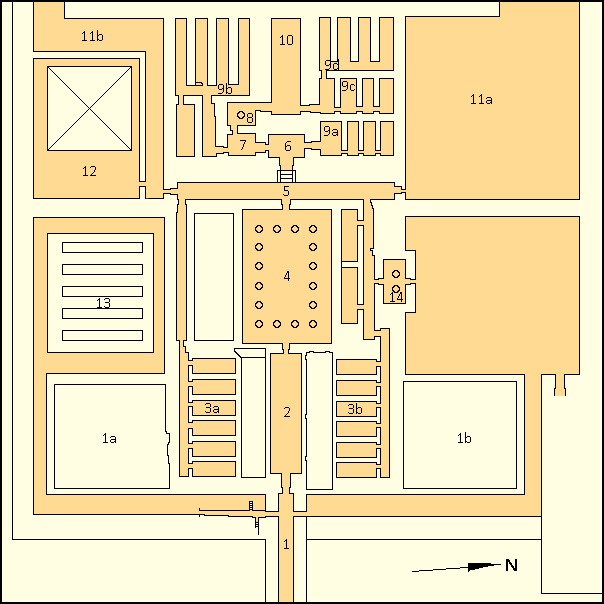
The entrance hall of the temple had an alabaster paved floor and appears to have had a vaulted ceiling, judging by the size of the walls, and is flanked on either side by six storage rooms. The storage rooms were accessed from the transverse corridor.
Leading to the southern storage rooms are a pair of corridors separated by a doorway. The western corridor is poorly preserved; the eastern corridor, which connects to the storage room, was found to be in better condition. The eastern corridor is 1.6 m (5.2 ft) wide and its preserved sections 14.25 m (46.8 ft) long. Significant remains of the original limestone pavement allowed for the outlines of the rooms to be reconstructed, despite their walls having been demolished. Although none of it remains, the corridor and the southern pylon are known to have been separated by a wall about two meters thick with no access route between them.
The storage rooms have walls that are of similar width at around 2 cu (1.0 m; 3.4 ft) and the rooms themselves measure about 5 cu (2.6 m; 8.6 ft) wide by 16.5 cu (8.6 m; 28.4 ft) long. The storage rooms to the north of the entrance hall are of similar size, but their state of preservation is significantly worse.
The entrance hall terminates into an open courtyard, paved with alabaster and adorned with sixteen pink granite columns. As in Sahure's temple, the columns bore the names and titles of Djedkare Isesi. The courtyard leads into the transverse corridor, with a low staircase in the west wall of the corridor leading into the inner temple. From here, a small passage led into the chapel with its five statue niches, followed by a vestibule leading into a small square room with a single granite column at its centre - the antichamber caree - before terminating at the offering hall.
The chamber measures 4.7 m (15 ft; 9.0 cu) by 4.2 m (14 ft; 8.0 cu). The north, east, and part of the south walls have been lost. Its central column supported the room's ceiling, and bore the names and titles of Djedkare Isese, as well as an image of Nekhbet the goddess of Upper Egypt. Shaped like a palm, the column was made of red granite and had a diameter of 0.65 m (2.1 ft) at the top and 0.73 m (2.4 ft) at its bottom. Some relief fragments previously discovered may come from the antichambre carree. These depict a variety of scenes including deities possessing Was-sceptres and ankh symbols, shrines of Upper and Lower Egypt, scenes of slaughter, and bowing officials. The offering hall of the temple is generally similar to other contemporary offering halls in other complexes, with the exception that the false door was carved into the masonry of the pyramid. Surrounding the inner temple were storage rooms on either side.
The temple was mostly destroyed during the Second Intermediate Period, and was used as a burial site in the Eighteenth Dynasty. Relief decoration is fragmentary, as extensive damage was done to the walls of the temple by stone thieves. The remnants indicate that the quality of execution both in design and workmanship is comparable to those at the other contemporary sites.
Four Djed pillars, three of which were preserved, were recovered from the mortuary temple. These pillars were each 93 cm (3.05 ft) tall, carved on two sides into Djed signs, and appear to have been used as an architectural element in one of the chambers of the temple. Their smooth tops indicate that they may have been used to hold some artifact, thus being used as stands. Two similar, but smaller, pillars were found in Unas' mortuary temple.
Statues of a lion and two sphinxes are another find in the complex. The lion statue, which was carefully sculpted and detailed, is 105 cm (3.44 ft) tall and 107 cm (3.51 ft) long. It is postured into a seated position with paws extended. It is broken, but otherwise very well preserved.
By contrast, the two sphinx statues are only partially preserved. They represent lions in resting positions on their bellies, and appear to have been wall decorations or part of another feature based on the fact that they are resting on rectangular pedestals. Sphinx statues in the Old Kingdom are a rarity, and the faces of both sphinx statues have been damaged.
A parallel exists in Unas' complex, and its face has been preserved. A reference to Djedkare's sphinx exists in a biographical inscription of a Kaemtjenenet, who was responsible for organizing the placement of the sphinx and its base in the mortuary temple. Limestone sculptures of kneeling captives have been found in the temple. Statues of kneeling figures are common, and have been attested to in the temples of Neferefre, Nyuserre, Unas, Teti and Pepi I. The likely providence of these statues are the causeway or entrance hall of the temple, where scenes of enemies being trampled would be found. Fragments of an alabaster statue of Djedkare were found in the temple, one of which bears an inscription.
South of the main mortuary temple was a large 21.8 m (72 ft; 41.6 cu) by 19.85 metres (65.1 ft; 37.88 cu) building of unknown height.[60] Within, there were apparently five, north to south oriented, rectangular rooms 14.3 m (47 ft; 27.3 cu) long by 2.15 metres (7.1 ft; 4.10 cu) wide.
Blocks from the foundation of the building have been preserved, but no blocks from a potential floor have been found. It is possible that the floor has been victim to stone quarrying for calcite, as has happened elsewhere in the temple, but physical evidence suggests that a limestone floor is much more likely. In this case, quality limestone must have made up the floor of building. No doors or connecting passages have been found, rendering it difficult to identify the access point into the building.
A corridor has been identified stretching from the south-west corner of the pylon, past the south side of the building, and to the enclosure wall of the cult pyramid, where it may have turned north to connect to the transverse corridor. A second potential corridor has been identified running along the east side of the building. It appears that this building was separate from its neighboring counterparts. The structure is otherwise poorly preserved, and its purpose unknown. No similar structure has been located at other contemporary pyramid complexes of the Old Kingdom, and no companion building on the north side of the mortuary temple either.
The complex includes a typical cult pyramid at the south-east corner of the pyramid. The pyramid was constructed with a core three steps high. The length of its base was 15.5 m (51 ft; 30 cu) inclined towards the apex at 65ˇ giving it a peak height of 16 m (52 ft; 31 cu). Entry into the substructure was gained through a door on the middle of its north face. The substructure had a standard T-shaped layout, consisting of a downward sloping corridor leading to a single rectangular chamber slightly beneath ground level which was oriented east-west. The cult pyramid was enclosed by a small perimeter wall.
The purpose of the cult pyramid remains unclear. It had a burial chamber but was not used for burials, and instead appears to have been a purely symbolic structure. It may have hosted the pharaoh's ka,or a miniature statue of the king. It may have been used for ritual performances centering around the burial and resurrection of the ka spirit during the Sed festival.
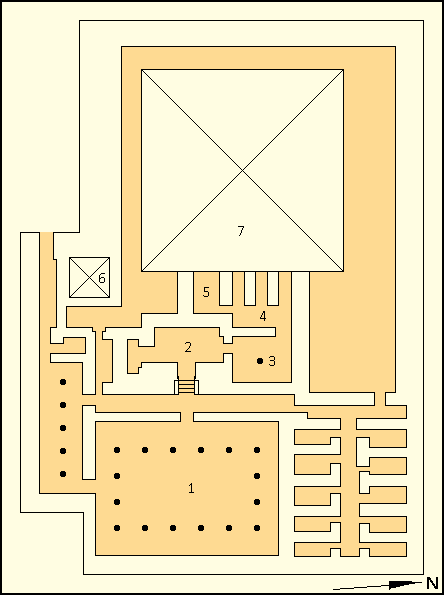
Layout of Setibhor's complex. In order: 1) Colonnaded courtyard; 2) Statue chapel; 3) Antichambre carrŽe; 4) Storerooms; 5) Offering hall; 6) Cult pyramid; 7) Main pyramid
A satellite pyramid complex is located at the north-east corner of the wall of the complex of Djedkare's pyramid. With the exception of a valley temple and causeway, the satellite pyramid has the standard elements that are typically found only in the king's pyramid.
The complex is enclosed within its own perimeter wall and consists of: a pyramid; colonaded court; statue chapel; a mortuary temple with its own offering hall, storage rooms, and antichambre carree with single column; and a small cult pyramid. The antichambre carree of this complex is notable due to its unparalleled size of 7 m (23 ft; 13 cu) by 6 m (20 ft; 11 cu). Its column and base appear to be both be made of limestone, instead of the typical granite. Relief fragments found on limestone blocks may also originate in the chamber.
Due to its being intentionally incorporated into the pyramid complex of Djedkare Isesi, the pyramid is believed to have belonged to a consort of Djedkare Isesi. The identity of the owner remained a mystery until 2019, when the name and titles of a queen Setibhor were found inscribed on a column in the complex. Setibhor's pyramid complex is thus the largest one built for a queen in the Old Kingdom, and incorporates elements that were previously only used in the complexes of the king.
In 1952, Fahkry explored a necropolis containing seventeen mudbrick tombs located south of the causeway and adjoining the east side of the mortuary temple. He provided a brief account summarizing that the tombs had been robbed of their contents.
In 2016, one of those tombs, mastaba MS1, was partially excavated and explored. The structure is dated to the Sixth Dynasty. The tomb measures approximately 5.5 m (18 ft) by 4 m (13 ft) and has six compartments arranged in two rows. The tomb is also connected to another tomb further east.
The first compartment at the north-west corner is accessed through a 4.73 m (15.5 ft) deep shaft leading into a vaulted burial chamber of dimensions 2.64 m (8.7 ft) by 0.85 m (2.8 ft). The chamber and shaft are made of mudbrick. The tomb has been emptied, except for some human remains. Two 2.8 m (9.2 ft) deep shafts, one directly south of the first and the other to its south-east, appear to have been built at the same time. They each lead into burial chambers of very similar proportions, both 3.5 m (11 ft) long by 0.95 m (3.1 ft) wide.
The south burial chamber contained fragments of human remains. These too were constructed entirely from mudbrick. They are connected by a 1 m (3.3 ft) vaulted passage. The middle compartment of the north row is arrived to by a 4.96 m (16.3 ft) deep. It contains a vaulted mudbrick burial chamber with dimensions of 2.62 m (8.6 ft) by 1.05 m (3.4 ft). This chamber has been blocked with a wall.The south-east compartment contains a vaulted mudbrick burial chamber 1.2 m (3.9 ft) by 1.3 m (4.3 ft) large. It was included as an apparent afterthought. Remains of multiple individuals were found in the chamber, but their origin is unclear. Other items recovered included faience beads and a seal stamp with a seated lion facing a crouching enemy. This type of seal can be dated to the Sixth Dynasty or the First Intermediate Period.
The north-east compartment is the largest and most significant of the tomb. It is accessed by a 4.75 m (15.6 ft) shaft. The vaulted mudbrick burial chamber here is 3 m (9.8 ft) long, 1.3 m (4.3 ft) wide, and 1.8 m (5.9 ft) tall. It contained a decorated limestone burial chamber 2.9 m (9.5 ft) long, 1.02 m (3.3 ft) wide, and 1.07 m (3.5 ft) tall which was originally closed with limestone slabs. The ceiling of the limestone burial chamber was painted black and red to imitate red granite. Its side walls were decoratively painted with scenes of offerings and a palace facade motif, and have been well preserved, except for at its southern section. Lines of inscription above the decorations identify the owner of the burial: Pepyankh Setju. Above the burial chamber, in the space with the vaulted mudbrick ceiling, an offering table bearing the name Isesi was found.
Djedkare Isesi (known in Greek as Tancheres) was a pharaoh, the eighth and penultimate ruler of the Fifth Dynasty of Egypt in the late 25th century to mid-24th century BC, during the Old Kingdom. Djedkare succeeded Menkauhor Kaiu and was in turn succeeded by Unas. His relations to both of these pharaohs remain uncertain, although it is often conjectured that Unas was Djedkare's son, owing to the smooth transition between the two.
Djedkare likely enjoyed a reign of more than 40 years, which heralded a new period in the history of the Old Kingdom. Breaking with a tradition followed by his predecessors since the time of Userkaf, Djedkare did not build a temple to the sun god Ra, possibly reflecting the rise of Osiris in the Egyptian pantheon. More significantly, Djedkare effected comprehensive reforms of the Egyptian state administration, the first undertaken since the inception of the system of ranking titles. He also reorganised the funerary cults of his forebears buried in the necropolis of Abusir and reformed the corresponding priesthood.
Djedkare commissioned expeditions to Sinai to procure copper and turquoise, to Nubia for its gold and diorite and to the fabled Land of Punt for its incense. One such expedition had what could be the earliest recorded instance of oracular divination undertaken to ensure an expedition's success. The word "Nub", meaning gold, to designate Nubia is first recorded during Djedkare's reign. Under his rule, Egypt also entertained continuing trade relations with the Levantine coast and made punitive raids in Canaan. In particular, one of the earliest depictions of a battle or siege scene was found in the tomb of one of Djedkare's subjects. Djedkare was buried in a pyramid in Saqqara named Nefer Djedkare ("Djedkare is perfect"), which is now ruined owing to theft of stone from its outer casing during antiquity. The burial chamber still held Djedkare's mummy when it was excavated in the 1940s. Examinations of the mummy revealed that he died in his fifties.
Following his death, Djedkare was the object of a cult that lasted at least until the end of the Old Kingdom. He seemed to have been held in particularly high esteem during the mid-Sixth Dynasty, whose pharaohs lavished rich offerings on his cult. Archaeological evidence suggests the continuing existence of this funerary cult throughout the much later New Kingdom (c. 1550-1077 BC). Djedkare was also remembered by the ancient Egyptians as the Pharaoh of Vizier Ptahhotep, the purported author of The Maxims of Ptahhotep, one of the earliest pieces of philosophic wisdom literature.
The reforms implemented by Djedkare are generally assessed negatively in modern Egyptology as his policy of decentralization created a virtual feudal system that transferred much power to the high and provincial administrations. Some Egyptologists such as Naguib Kanawati argue that this contributed heavily to the collapse of the Egyptian state during the First Intermediate Period, c. 200 years later. These conclusions are rejected by Nigel Strudwick, who says that in spite of Djedkare's reforms, Ancient Egyptian officials never amassed enough power to rival that of the king.
Djedkare is well attested in sources contemporaneous with his reign.] The tombs of many of his courtiers and family members have been discovered in Giza, Saqqara and Abusir. They give insights into the administrative reforms that Djedkare conducted during his reign and, in a few cases, even record letters that the king sent to his officials. These letters, inscribed on the walls of tombs, typically present royal praises for the tomb owner.
Another important source of information about Egypt during the reign of Djedkare is the Abusir papyri. These are administrative documents, covering a period of 24 years during Djedkare's reign; they were discovered in the mortuary temples of pharaohs Neferirkare Kakai, Neferefre and queen Khentkaus II. In addition to these texts, the earliest letters on papyrus preserved to the present day also date to Djedkare's reign, dealing with administrative or private matters.
Djedkare is attested in four ancient Egyptian king lists, all dating to the New Kingdom. The earliest of these is the Karnak king list, dating to the reign of Thutmose III (1479-1425 BC), where Djedkare is mentioned on the fifth entry. Djedkare's prenomen occupies the 32nd entry of the Abydos King List, which was written during the reign of Seti I (1290-1279 BC).
Djedkare is also present on the Saqqara Tablet (31st entry) where he is listed under the name "Maatkare", probably because of a scribal error. Djedkare's prenomen is given as "Djed" on the Turin canon (third column, 24th row), probably because of a lacuna affecting the original document from which the canon was copied during the reign of Ramses II (1279-1213 BC). The Turin canon credits Djedkare with 28 years of reign.
In addition to these sources, Djedkare is mentioned on the Prisse Papyrus dating to the 12th Dynasty (c. 1990-1800 BC). The papyrus records The Maxims of Ptahhotep and gives Djedkare's nomen "Isesi" to name the pharaoh whom the purported authors of the maxims, vizier Ptahhotep, served. Djedkare was also probably mentioned in the Aegyptiaca history of Egypt written in the 3rd century BC during the reign of Ptolemy II (283-246 BC) by the Egyptian priest Manetho. No copies of the Aegyptiaca have survived to this day and it is known to us only through later writings by Sextus Julius Africanus and Eusebius. Africanus relates that a pharaoh Tancheres reigned for 44 years as the eighth and penultimate king of the Fifth Dynasty. Given its position within the dynasty, Tancheres is believed to be his Hellenized name.